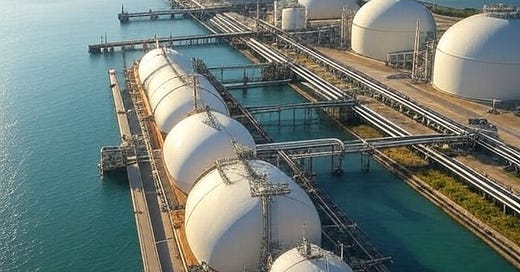This week, the Trump-Vance Department of Energy (DOE) published its Response to Comments on the 2024 LNG Export Study: “Energy, Economic, and Environmental Assessment of U.S. LNG Exports,” published last December.
“President Trump was given a mandate to unleash American energy dominance, and that includes U.S. LNG exports,” Energy Secretary Chris Wright said in a press release. “The facts are clear: expanding America’s LNG exports is good for Americans and good for the world.”
The Biden administration published this report to discourage future LNG export terminal projects, after it enacted a pause on new project construction in January 2024, citing input from climate activists. The last administration deemed these projects not to be in the “public interest” on economic and environmental grounds, instead favoring wind and solar energy.
The Biden DOE report claimed “unfettered” natural gas exports will annually increase natural gas plus electricity expenditures by $122.54 per household and result in “1.5 gigatons of direct greenhouse gas emissions” annually. The report, however, misled on these two important points.
With respect to the 2024 report’s section on “Domestic Energy, Economic, and GHG Assessment of U.S. LNG Exports,” Commonwealth LNG said “… since 2010, while the volumes of domestic LNG exports have increased by over 500%, Henry Hub gas prices have decreased by 40%, and domestic natural gas prices remain one of the only commodities to resist inflation and remain flat.”
Boosting LNG exports is, in fact, good for America. Natural gas is a clean-burning fuel that emits 50 to 60% fewer emissions than coal.
Increased production is often associated with lower natural gas prices. The Energy Information Administration (EIA) reported increased U.S. natural gas production between August and December 2024—from 3.85 billion cubic feet (Bcf) to nearly 4 Bcf—led to cheaper prices for both residential (from $23.45/Mcf to $12.98/Mcf) and commercial (from $10.86/Mcf to $9.93/Mcf) customers.
“Despite record U.S. LNG exports, Americans enjoy some of the lowest residential natural gas prices in the world,” Charlie Riedl, executive director of the Center for LNG, told E&E News last month. “Since first export in 2016, natural gas production has outpaced LNG export growth nearly threefold, and Henry Hub prices have averaged 37% lower than the previous decade.”
Due to growing demand for natural gas, prices might increase slightly in 2025 and 2026. But export volumes, themselves, don’t impact prices. The underlying issue, instead, is infrastructure constraints.
A 2018 DOE study noted, “U.S. natural gas prices are far more dependent on available resources and technologies to extract available resources than on U.S. policies surrounding LNG exports.”
The Trump administration is fast-tracking outstanding requests and approving new LNG export terminals. As of May 2025, here’s the breakdown of LNG projects per the Federal Energy Regulatory Commission (FERC):
8 approved and under construction
13 approved LNG projects awaiting construction
2 pending approval
Natural gas accounts for 43.1% of net U.S. electricity generation. Natural gas-fired plants supply reliable power for nearly 60% of the year. This energy source will also help meet growing electricity demand, which largely comes from artificial intelligence (AI) data centers. That’s where more LNG export terminal infrastructure projects can play a role.




